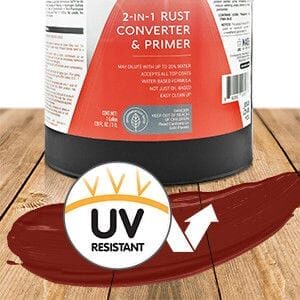No products in the cart.
Rust converters are popular as they can help take care of our belongings. They can convert rust on tanks, staircases, cars, gates, shelves, etc. Rust converters contain Tannic acid and an organic polymer, which reacts with the iron oxide on the rust. It’s a water-based primer that is usually used on an object made of iron or iron. It turns rust into a stable, black substance, which is why a lot of people ask can you paint over the rust converter.
Homeowners need to know how rust converters work to take care of their belongings more effectively. It is essential because it helps you save a lot; you would otherwise have to spend on replacing the items. It also helps to limit the rust in the future, which makes them less prone to rust corrosion and damage. This is why it is important to explore questions like, “can you paint over rust converter?”
This article is designed to answer all your questions about rust converters so you can take care of your house in a better way.
What is a Rust Converter?
Before answering the question ‘can you paint over rust converter,’ it is more vital to know how to use rust converters efficiently. It converts rust into an inert, black polymeric coating that can be used for protecting the metal object in the future. The coating is helpful in protecting the metal object. It even makes for the perfect primer, which means you can use any oil or epoxy-based paint on it.
Rust converters are different from rust removers, but a lot of people still confuse the two items. Rust removes harmful and dangerous since they contain a high concentration of acids. These acids help cut through the rust, but can sometimes even damage the metal surface. If you aren’t careful, the acid can corrode the metal. This can cause it to weaken and collapse under the weight.
Unlike rust converters, rust removers also do nothing to help prevent future rusting at all. This is because they only have a onetime use. They do not form any protective coating on the metal object at all. It can also be dangerous to keep them in the house since they can cause many health problems in ingested or touched by bare skin.
This is why a lot of experts prefer rust converters.

Can You Paint Over Rust Converters?
Now that you have an overview of how rust converters work, you can answer the question, can you paint over rust converter? Rust converters are a mixture of two main ingredients; it contains tannic acid and an organic polymer. The first ingredient, Tannic acid, is the primary ingredient to react with the iron oxide (also known as rust). The chemical reaction that takes between the tannic acid and iron oxide forms an iron tannate. This iron tannate is a stable, black colored coating that covers the metal object.
A lot of people worry that the tannic acid may harm their belongings like rust removers often do. Rust removers have a high concentration of acids, while the tannic found in rust converters are naturally occurring. It can be found in everyday things like fruits, grasses, and trees. This means that it won’t harm your belongings at all.
2-Butoxyethanol is an active ingredient that is also commonly known as an organic polymer. This is the ingredient that reacts with the rust and tannate to form a protective layer over the metal object. This helps to prevent rust and corrosion in the future as well. This protective layer is the correct answer to the question of can you paint over rust converter. This layer forms the perfect primer for oil or epoxy-based paints. This means you can even paint over rust converters.
Is the Paint Necessary?
It is recommended that you should paint on the surfaces you use rust converters on. You can leave the painting bit, but rust converters leave behind a black, inert substance. You wouldn’t want an unappealing black color on your objects, so it is better to paint it.
Experts recommend having a layer of paint on the metal surface since it can help protect the item from future corrosion and rust. Even applying one layer of paint can vastly improve the safety of the item overall. To increase the coverage of the whole object, it is essential to add a second layer of paint. This will ensure that all the rust has been properly converted and covered by the protective layer of the paint and primer.
The critical question isn’t just can you paint over rust converter, but how will paint help? The paint forms a protective coating on the surface, protecting the item from all sorts of harm. It shields the metal object from rain, direct sunlight, direct contact to oxygen, and salt mist. If you live near coastal areas, you may need to invest in rust converters immediately. This is because rust develops quickly in such areas due to the salt. The protective layer of organic polymer ensures that the paint won’t crack or peel over time either. This keeps the object secure for a long time.
However, while you are painting, make sure that you don’t use latex, powder, or water-based paints. This is because they often do not mix properly with the layer of primer and black, polymeric substances called tannate. The primer that rust converters form is perfect for oil or epoxy-based paints, so it is important to use these. They form the perfect coating for the metal surface to protect it.
What Can You Use A Rust Converter On?
Now that you know if you can paint over rust converters, it is time to learn what you can use it on. It is important to know that rust converters only work where iron oxide exists. This means they only work on items that are made from iron or iron alloy. They do not work on stainless steel, zinc, galvanized metal, copper, or aluminum.
You should use them on items that you want to paint over since they leave a black, inert substance behind that can be unappealing to look at. It provides no extra protection if you use it on non-rusty metal surfaces. This is because the protective coating only forms if rust converters react with the rust.
They can be used on any iron or iron alloy object like lawn equipment, mower decks, staircases, iron railings, vehicles, gates, fences, trailers, sheet metal, farm equipment, tanks, cast iron, tractors, and many other items.
Do Rust Converters Require Preparation?
Even though you know if you can paint over rust converters, it is still not enough knowledge to know how to use them effectively. Rust converters do require some preparation before you can use them directly on the metal surface. It is pretty easy and simple to use.
Experts recommend that you first scrape off large rust pieces, and then scale particles with a hammer, sandpaper, or stiff-bristled brush. This can make the surface more stable, even since all the loose rust and flaking are gone. Make sure not to remove all the rust from the surface, because rust converters do need some to properly react with. This will help form the protective layer over the metal surface.
You also have to make sure the metal surface doesn’t have grease on it. This is because rust converters can break through these substances. Salt can also make it harder for the rust converter to work efficiently. Clean the surface thoroughly with water and make sure it is dry before using the rust converter. This is because rust converters are water-soluble, which means they will just dissolve around water.
How to Apply Rust Converters?
You do not need thinner while using rust converters. The mixture can be used as it comes from the bottle. Most rust converters do need a little shake or stirring, though before you can use them.
Rust converters can be easily applied with rollers or brushes. For smaller spaces like railings or frames, you can use a brush, but for larger surfaces like doors or cars, you may need bigger rollers. For irregular surfaces, it is easier to use spray rust converters. However, these only work if you have an airless spray on hand since rust converters may become contaminated if exposed to air.
You will need a gallon of rust converter to approximately cover 500 square feet of rusted metal surfaces with a protective layer. Spray-able rust converters have low coverage of only 300 square feet for a gallon of rust converters. Aerosol rust converters have the lowest coverage of 24 square feet per gallon.
It is important to wait 10 minutes before applying the second coat of rust converter and 48 hours before the paint layer. This is because the rust converter needs proper time to complete the chemical reaction so that all of the rust is gone. Wipe the metal surface with a damp cloth to clean away the excess rust converter, let the surface dry, and then paint the surface with ease.
Tips To Use Rust Converter
While using rust converters, there are a few things that users have to be careful about. Since you are using this at home, it is important to educate yourself further than can you paint over rust converters. Here are a few tips that might help you out while using rust converters in the home.
- Rust converters are not heated resistance, so it is important to note use them on any surface that will be regularly exposed to heat. This includes grills, cast iron stoves, engines, boilers, furnaces, water heaters, etc.
- Make sure to clean the application tools after you have applied the rust converter. They can be cleaned easily with water since rust converters are soluble in water. They have organic tannins and water-based primers. Use a combination of soap and water to clean.
- Rust converters can only be used on iron or iron alloy products. They can’t be used on objects like galvanized steel, which is covered in zinc.
- They can be used without painting, but the paint helps to form a protective layer on the surface.
- Rust converter is soluble in water, which means they shouldn’t be used on surfaces exposed to water a lot like the inside of a water tank however if you do use two coats of paint to ensure that nothing is damaged.
- Rust converters have a shelf-life of only nine months, so make sure you get a fresh batch when you want to use it. It isn’t dependent on whether you have opened the bottle or not.
- Rust converters do not work in harsh conditions like extreme temperatures. They work best in temperatures between 50 to 100 Fahrenheit degrees.
- Do not pour any unused liquid back into the bottle since it can contaminate the one inside the bottle. It will make the rest of the rust converter less effective since it will contaminate the bottle.
- Use goggles or safety glasses and chemically resistant gloves as rust converter can cause mild irritation on the skin and eyes. It is better to take caution.
- Wear inexpensive clothing since it can stain clothes.
- Seek medical attention if ingested since it contains tannic acid. Keep away from pets and children, as well as food and water.
- Use in a well-ventilated area to avoid any fumes from the rust converter.
- Do not store in hot or cold conditions.
- Doesn’t mix well with powder coatings or latex and water paints. It causes flaking and peeling off of paints.
- Make sure you dispose of the rust converter according to the federal or state guidelines so that it doesn’t harm anyone or hurts the environment.
Contact us for more information.

